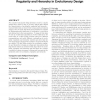Free Online Productivity Tools
i2Speak
i2Symbol
i2OCR
iTex2Img
iWeb2Print
iWeb2Shot
i2Type
iPdf2Split
iPdf2Merge
i2Bopomofo
i2Arabic
i2Style
i2Image
i2PDF
iLatex2Rtf
Sci2ools
66
Voted
GECCO
2005
Springer
2005
Springer
Measuring, enabling and comparing modularity, regularity and hierarchy in evolutionary design
For computer-automated design systems to scale to complex designs they must be able to produce designs that exhibit the characteristics of modularity, regularity and hierarchy – characteristics that are found both in man-made and natural designs. Here we claim that these characteristics are enabled by implementing the attributes of combination, control-flow raction in the representation. To support this claim we use an evolutionary algorithm to evolve solutions to different sizes of a table design problem using five different representations, each with different combinations of modularity, regularity and hierarchy enabled and show that the best performance happens when all three of these attributes are enabled. We also define metrics for modularity, regularity and hierarchy in design encodings and demonstrate that high fitness values are achieved with high values of modularity, regularity and hierarchy and that there is a positive correlation between increases in fitness and ...
| Added | 27 Jun 2010 |
| Updated | 27 Jun 2010 |
| Type | Conference |
| Year | 2005 |
| Where | GECCO |
| Authors | Gregory Hornby |
Comments (0)

